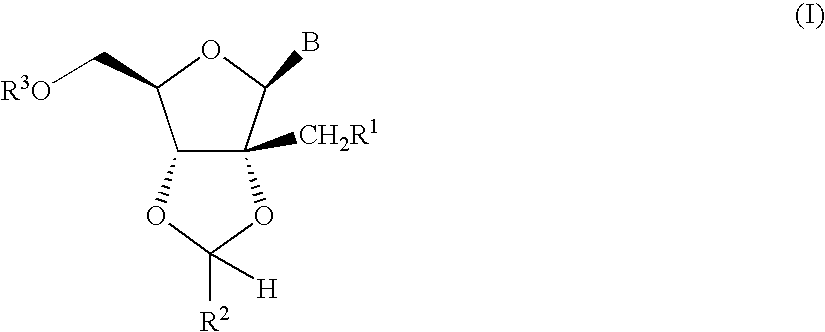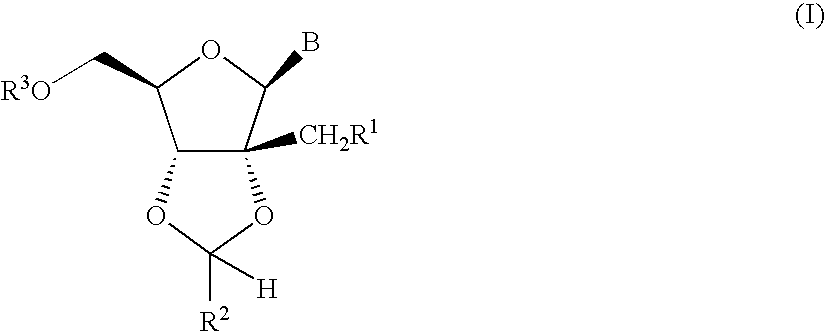Ribonucleoside cyclic acetal derivatives for the treatment of RNA-dependent RNA viral infection
a technology of cyclic acetal derivatives and ribonucleosides, which is applied in the field of 2′, 3′cyclic acetal derivatives of ribonucleosides, can solve the problems of limited clinical benefit, no established vaccine for hcv, and treatment of hcv infection
- Summary
- Abstract
- Description
- Claims
- Application Information
AI Technical Summary
Benefits of technology
Problems solved by technology
Method used
Image
Examples
example 1
[0179]
[0180]A suspension of 2′-C-methyladenosine [prepared following the conditions described in J. Med. Chem., 41: 1708 (1998)] (6.50 g, 23.1 mmol), zinc(II) chloride (15.8 g, 115.5 mmol) and p-chlorobenzaldehyde (32.5 g, 231 mmol) in dry tetrahydrofuran (20 mL) was stirred at 60° C. for 12 h. The reaction was quenched with aqueous solution of sodium hydroxide (150 mL, 2N) and the crude product was extracted with chloroform (2×250 mL). The combined organic extracts were dried with anhydrous magnesium sulfate and the solvent was removed in vacuo. The residue was further purified by column chromatography on silica gel using 9:1 dichloromethane / methanol as eluant to afford a mixture of the two diastereomeric (5:1 ratio) products as a white powder. 1H NMR (500 MHz, dimethylsulphoxide-d6): Major isomer: δ=8.40 (s, 1H), 8.15 (s, 1H), 7.65 (d, J=8.24, 2H), 7.54 (d, J=8.23, 2H), 7.36 (brs, 2H), 6.40 (s, 1H), 6.18 (s, 1H), 5.42 (t, J=5.49, 1H), 4.71 (d, J=3.43, 1H), 4.28 (q, J=3.54, 1H), 3....
example 2
[0181]
[0182]A suspension of 2′-C-methyladenosine (140 mg, 0.5 mmol), p-toluenesulfonic acid monohydrate (144 mg, 0.75 mmol) and propionaldehyde dimethylacetal (417 mg, 4 mmol) in dry N,N-dimethylformamide (4 mL) was stirred at 25° C. for 12 h. Additional propionaldehyde dimethylacetal (417 mg, 4 mmol) and p-toluenesulfonic acid monohydrate (432 mg, 2.25 mmol) were added and the mixture was heated to 50° C. for 3 h. The reaction was quenched with an aqueous solution of saturated sodium bicarbonate (5 mL) and the crude product was extracted with tert-butyl methyl ether (4×20 mL). The combined organic extracts were dried with anhydrous magnesium sulfate and the solvent was removed in vacuo. The residue was further purified by mass directed HPLC chromatography (reversed phase, Waters Sunfire Prep C18 ODB 10 μm [30×100 mm], acetonitrile [0.1% TFA] / water [0.1% TFA] gradient) to afford the product as a clear oil. 1H NMR (500 MHz, dimethylsulphoxide-d6): δ=8.55 (s, 1H), 8.35 (s, 1H), 6.24 (...
example 3
[0183]
[0184]A suspension of 2′-C-methyladenosine (240 mg, 0.85 mmol), zinc(II) chloride (581 mg, 4.3 mmol) and p-trifluoromethylbenzaldehyde (2 mL) was stirred at 60° C. for 12 h. The aldehyde was removed via distillation. The residue was purified by mass directed HPLC chromatography (reversed phase, Waters Sunfire Prep C18 ODB 10 μm [30×100 mm], acetonitrile [0.1% TFA] / water [0.1% TFA] gradient) to afford the pure product (white powder) as a mixture of two diastereomers (4:1 ratio). 1H NMR (500 MHz, methanol-d4): Major isomer: δ=8.68 (s, 1H), 8.38 (s, 1H), 7.84 (d, J=8.23, 2H), 7.77 (d, J=8.24, 2H), 6.54 (s, 1H), 6.32 (s, 1H), 4.80 (d, J=2.97, 1H), 4.44 (q, J=3.00, 1H), 3.96 (dd, J′=3.43, J″=12.36, 1H), 3.88 (dd, J′=3.43, J″=12.35, 1H), 1.28 (s, 3H). Minor Isomer: δ=8.68 (s, 1H), 8.38 (s, 1H), 7.73 (m, 4H), 6.56 (s, 1H), 6.39 (s, 1H), 4.75 (d, J=4.57, 1H), 4.44 (q, J=3.00, 1H), 4.04 (dd, J′=2.75, J″=12.36, 1H), 3.92 (dd, J′=3.21, J″=12.36, 1H), 1.20 (s, 3H). 13C NMR (500 MHz, metha...
PUM
 Login to View More
Login to View More Abstract
Description
Claims
Application Information
 Login to View More
Login to View More - R&D
- Intellectual Property
- Life Sciences
- Materials
- Tech Scout
- Unparalleled Data Quality
- Higher Quality Content
- 60% Fewer Hallucinations
Browse by: Latest US Patents, China's latest patents, Technical Efficacy Thesaurus, Application Domain, Technology Topic, Popular Technical Reports.
© 2025 PatSnap. All rights reserved.Legal|Privacy policy|Modern Slavery Act Transparency Statement|Sitemap|About US| Contact US: help@patsnap.com



